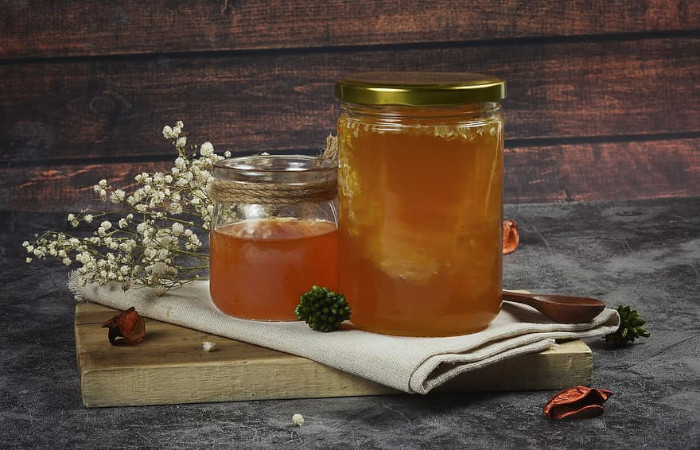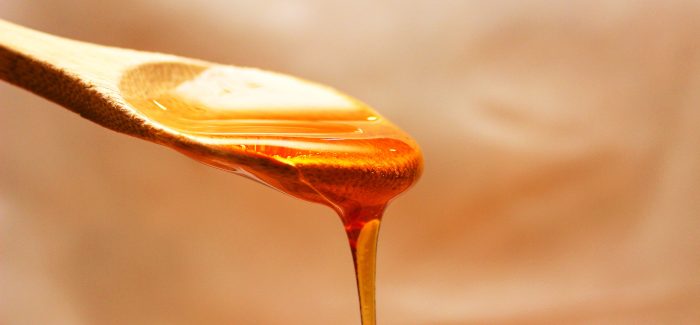From porchdrinking.com
While it has been used for thousands of years in brewing, honey is an up and coming star of the craft beer world. Brewers are becoming more aware of the myriad possibilities it presents. Honey provides multiple potential contributions to beer depending on how and when it’s used in the brewing process and has a dizzying range of flavors. Factors such as terroir, the botanicals visited by the bees, and even the time of year the pollen was gathered all affect flavour. So what exactly does honey do for beer, and why do breweries use it?
Honey, the Most Ancient of Fermentables
The main reason honey has been used in beer throughout history is because it’s a fermentable sugar. Honey contains approximately 40 percent fructose and 30 percent glucose, along with traces of other less fermentable sugars. Mead, arguably the world’s oldest alcoholic beverage, is a type of wine made today primarily, or solely, from honey. Historically, though, honey was mixed in with fruit, malted grain and any other flavoring or fermentable ingredient to make what was essentially a barley wine.
Getting enough sugar from malted grains to ferment into beer takes a good amount of human intervention. For honey, the bees have done all the work for us. Sugar (about 50/50 fructose and glucose) is also used in beer by some brewers as an affordable method for boosting ABV (alcohol by volume) while also drying out the mouthfeel. The advantage of using honey is that it often leaves some residual sweetness and aroma behind due to sugars it contains that are too complex to fully ferment.
The Vast World of Honey Flavors
The geographical region and temperate climate where pollen is gathered by bees and the type of botanicals they visit all play a role in what type of honey is produced. For example, honey produced from wildflowers such as clover tends to be very light and delicate; honey gathered from buckwheat produces a dark honey with a molasses-like flavor and consistency. Humid locales also produces a more moist honey than arid environments.
If you really want to get an idea as to the many flavours of honey, check out this Honey Varietal Guide from the National Honey Board that is used by the Beer Judge Certification Program (BJCP), or check out this Honey Flavor Wheel produced by UC Davis. Overwhelmed by the range of possible flavours? When tasting honey, honey sommelier Alison Conklin of the National Honey Board suggested in a recent media presentation breaking your reaction down to the 4 Fs: “floral, fruity, funky or a favorite that you cannot put your finger on.”

How to Bee a Good Brewer
After choosing the type of honey, brewers have to decide exactly how and when to add it to the beer. Honey is full of acids, minerals, vitamins, yeasts, bacteria and enzymes. These can all potentially help or harm a beer. Pasteurizing honey by adding it during the “hot side” of brewing (boil through flameout) can kill any wild yeast or bacteria, but it can also reduce or eliminate the honey’s delicate aroma. Some brewers choose to add it to the “cool side” after cooling down the wort to fermentation temperature. Although there is a chance wild yeast and bacteria can cause off flavors in a “cool” fermentation, many brewers and mead makers think it’s worth the minimal risk.
One final use for honey in beer is bottle-conditioning, to provide natural carbonation. In order to provide a shelf-stable product, most commercial brewers force carbonate with CO2 before bottling or canning. Some brewers prefer to carbonate their beers as close to how Mother Nature intended. Breweries that employ natural carbonation of their beers through honey include The Ale Apothecary and Cellador Ales. Paul Arney of The Ale Apothecary employs 100% natural carbonation in all of his beers. Sometimes fruit juice is used for this process, but it’s often honey. Kevin Osborne of Cellador Ales told us in an email that “it felt like a shame to add sucrose to a product that we tried hard to source the best malt, hops, barrels, and fruit for.” He also feels that honey “leaves the perception of sweetness or fulness in the finished project even after all the sugar is fermented out."
https://www.porchdrinking.com/articles/2020/12/21/whatcha-brewing-honey/

No comments:
Post a Comment